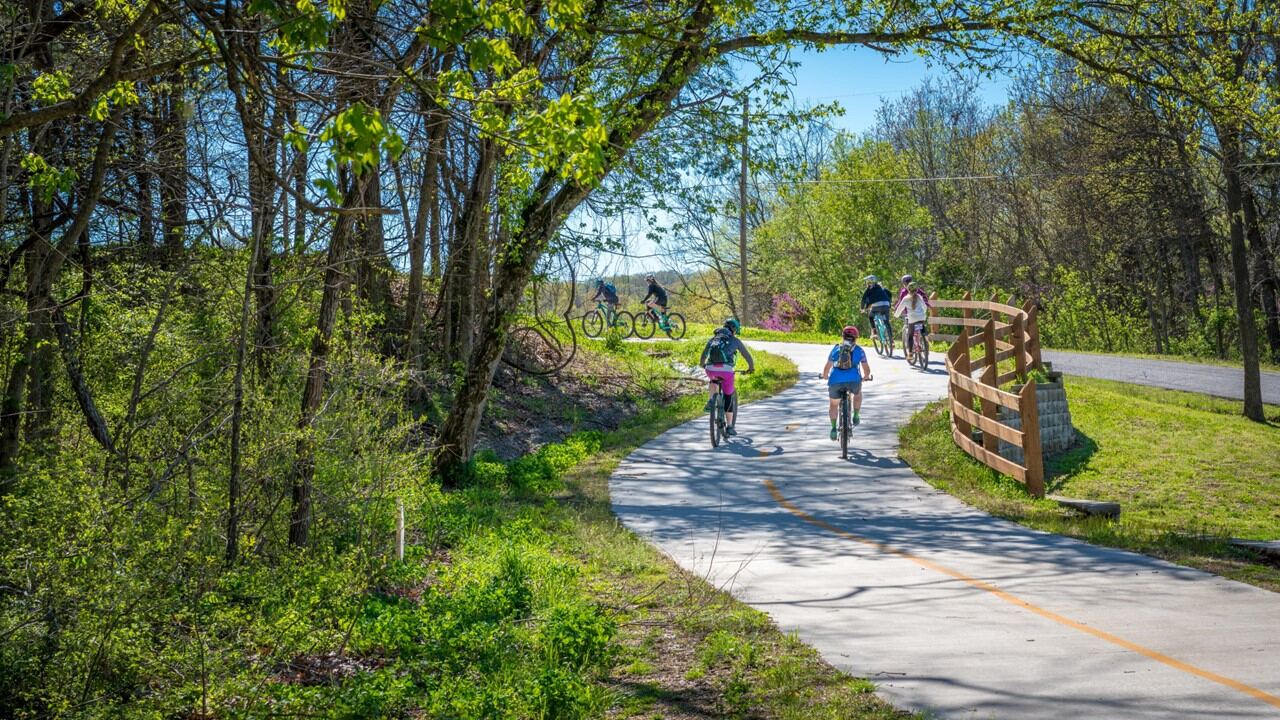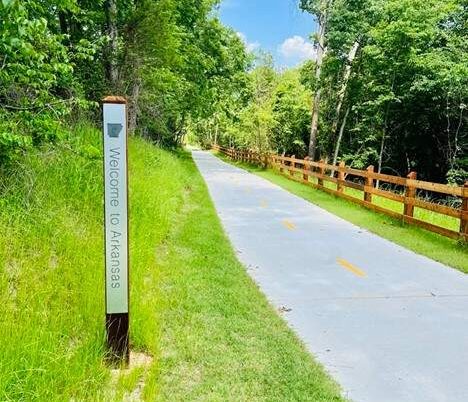The Evolution of Trails and Mobility Across Northwest Arkansas
Northwest Arkansas has experienced tremendous growth in trails and mobility. The Razorback Greenway, a 40-mile paved trail built to connect the region, became the catalyst that established a foundation for future trail development.
Background: A Regional Connector
The Razorback Greenway trail originated in 1990 when the concept of a regional greenway was first introduced. Today, the trail links dozens of destinations across the region. The success of the Razorback Greenway sparked a growing trend in the demand for trail systems in the region. Serving as the main spine, the trail facilitated connectivity between the northern and southern regions, primarily intended for recreational purposes.
The Razorback Greenway began extending eastward and westward, establishing greater connectivity in the region and leading to significant changes. While the original trail was mostly 10 feet wide, current trails are now being constructed with widths of 12 to 14 feet, depending on the number of daily users. Hard surface trails, which initially served recreational purposes, have begun shifting toward functionality and connectivity. Meanwhile, soft surface trails, primarily used for mountain biking, transitioned from hand-cut paths created by individuals to multi-million-dollar projects.
Razorback Greenway Trail in Rogers, AR.
Many of the cities across Northwest Arkansas, as well as Federal funding agencies and local nonprofit organizations, dedicated significant resources to the development of the region. Much of these funds were allocated to create a variety of trails designated for a range of experience levels, including cross-country trails, downhill trails, gravity trails and more.
These investments have been a tourism and revenue driver for the region. While the initial goal was to create recreational and mountain bike trails, municipalities have started to place a larger focus on transportation and utilitarian trail designs.
Hard vs. Soft Surface Trails
Lake Frances Trail in Siloam Springs, AR (left, hard surface) and Tweety Bird Trail in Bella Vista, AR (right, soft surface).
As the first major hard surface trail in the region, the Razorback Greenway became a main spine that opened doors for many extensions. These trails became popular among locals, who used them for leisure. But the Razorback Greenway would soon branch paths that moved from recreational use toward functionality and connectivity.
Soft surface trails have evolved from simple, hand-cut paths created by smaller groups of individuals to multi-million-dollar projects. Historically, trails such as those found in Devil’s Den State Park or Kessler Mountain and Slaughter Pen were among the few available. However, local nonprofits, philanthropies and private family donations have since developed a variety of trail experiences, particularly in Bentonville, which is recognized as the “Mountain Biking Capital of the World.”
Community Impact and Benefits of Trails
Trails have improved the quality of life for residents and have driven the economy. Not only have trails introduced a physically healthier lifestyle for people, they have also encouraged interaction within the region, bringing a sense of community. Meanwhile, the economic impact from tourism that the extensive network of trails brings allows businesses in the region to flourish. Hotels, restaurants, souvenir shops and more have benefitted from the crowds that gather to hike or ride one of Northwest Arkansas’ many trails.
While the Razorback Greenway brought some tourism initially, traffic accelerated when cities started investing more in mountain biking. The mountain bike scene is worldwide, and Northwest Arkansas has attracted people from all over the world to come ride the region’s trails. Big events and mountain biking championships have made the economic impact much more evident. Additionally, bike manufacturers have moved to the area, and international bike brands are bringing experience centers.
Challenges of Trails in Northwest Arkansas
Some of the largest challenges the ever-growing network of trails in the region faces include:
-
-
- Funding
- Maintenance
- Regional connectivity
-
While many entities front the money for the design and construction of the trails, they are typically handed over to the city after completion. Unfortunately, cities often don’t have the trained staff needed to maintain such a vast network of trails and have difficulty obtaining long-term maintenance funding for them. Cities are relying heavily on volunteer organizations to care for the trails, such as the Friends of Arkansas Singletrack (FAST) and Trailblazers.
Regional connectivity has also been a challenge in terms of getting the master trail plans for all the large communities to inform each other to ensure connectivity across communities. The Southwest Bentonville Loop, which Halff is involved with, aims to resolve connectivity issues by implementing a huge master loop of connecting trails.
Clearing a Path for the Future
The future of trails in Northwest Arkansas is ever evolving as municipalities shift gears and turn a focus on functionality and connectivity. In the past, recreational use of trails was put at the forefront when it came to designing trails. Functionality and micromobility have become the focus in recent years, however, demanding a different approach.
Cities are reconsidering the need for wide roads, using that extra space to paint bike lanes with physical barriers for safety. Cities want to use resources they already have, and since roads are already designed to get people from point A to point B, the clear solution is to put a trail right next to it or on the road, which brings up the need for on-street facilities. This is the direction many cities are taking as we start to see more protected bike lanes and intersections.
WOKA Trail in Siloam Springs, AR.
More amenities are also being implemented along the trails to accommodate users of all ages. These amenities include improving existing trail infrastructure by adding lighting, seating, wayfinding signage and trash receptacles.
How Can Halff Help?
Halff’s landscape architects know how to design trails for the demands of the future. As trail users themselves, our professionals bring a unique perspective when designing trails. They know how trails should look and feel. They know how they should be built to accommodate flooding and withstand the ever-changing ecology of the creeks and rivers. Our professionals know that trails are not just mini roads, they are intricate pathways built specifically for pedestrians.
Currently, Halff professionals have been working alongside our Funding Resources team to find and secure state or federal funding for many Northwest Arkansas communities.
Partner with Halff by contacting Planning/Landscape Architecture Director Jacob Shy (jshy@halff.com) and Senior Project Manager Carter Smith (carter.smith@halff.com).







